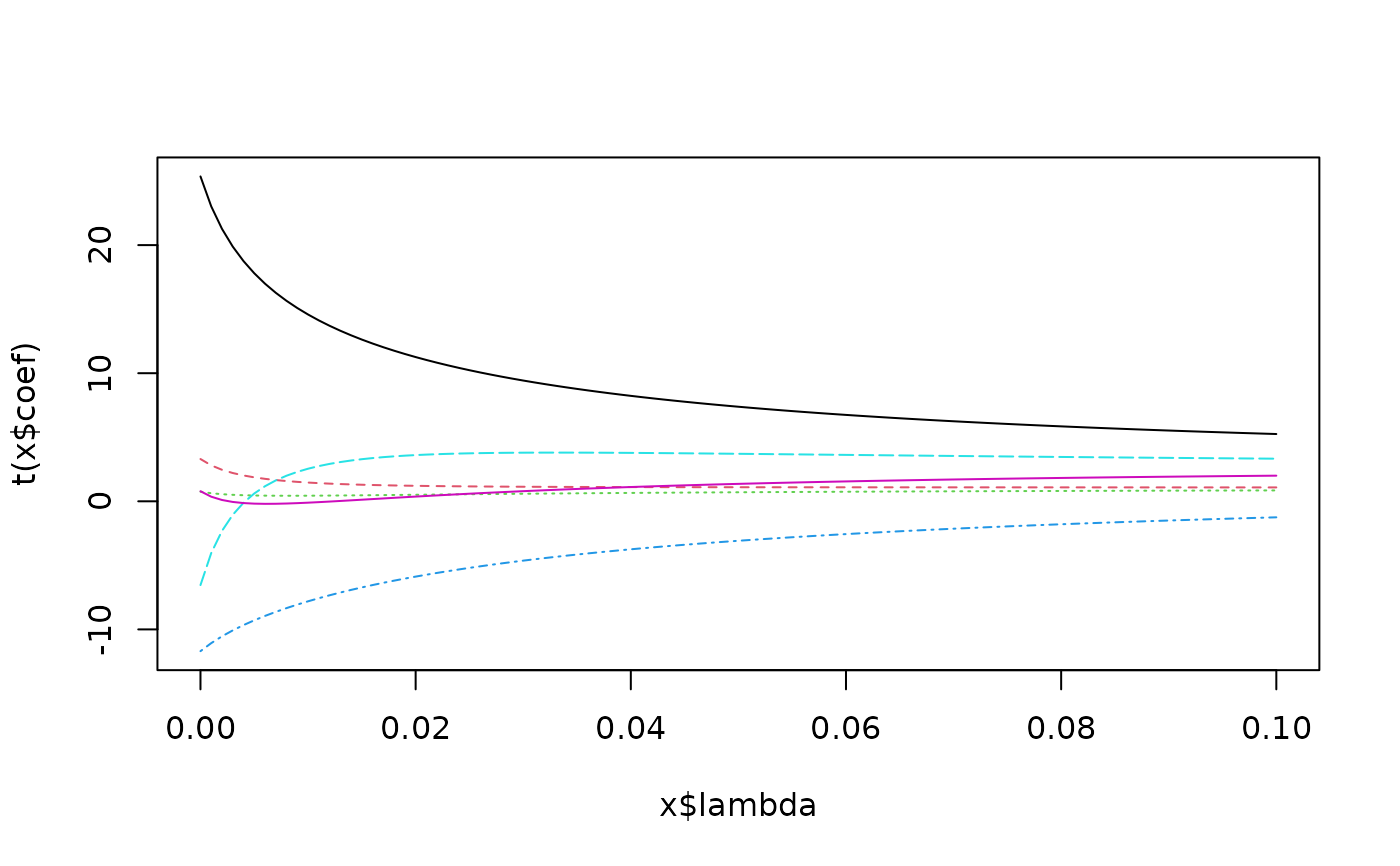Ridge Regression
lm.ridge.RdFit a linear model by ridge regression.
lm.ridge(formula, data, subset, na.action, lambda = 0, model = FALSE,
x = FALSE, y = FALSE, contrasts = NULL, ...)
select(obj)Arguments
- formula
a formula expression as for regression models, of the form
response ~ predictors. See the documentation offormulafor other details.offsetterms are allowed.- data
an optional data frame, list or environment in which to interpret the variables occurring in
formula.- subset
expression saying which subset of the rows of the data should be used in the fit. All observations are included by default.
- na.action
a function to filter missing data.
- lambda
A scalar or vector of ridge constants.
- model
should the model frame be returned? Not implemented.
- x
should the design matrix be returned? Not implemented.
- y
should the response be returned? Not implemented.
- contrasts
a list of contrasts to be used for some or all of factor terms in the formula. See the
contrasts.argofmodel.matrix.default.- ...
additional arguments to
lm.fit.- obj
an R object, such as an
"lm.ridge"fit.
Details
If an intercept is present in the model, its coefficient is not penalized. (If you want to penalize an intercept, put in your own constant term and remove the intercept.)
Value
A list with components
- coef
matrix of coefficients, one row for each value of
lambda. Note that these are not on the original scale and are for use by thecoefmethod.- scales
scalings used on the X matrix.
- Inter
was intercept included?
- lambda
vector of lambda values
- ym
mean of
y- xm
column means of
xmatrix- GCV
vector of GCV values
- kHKB
HKB estimate of the ridge constant.
- kLW
L-W estimate of the ridge constant.
References
Brown, P. J. (1994) Measurement, Regression and Calibration Oxford.
See also
Examples
longley # not the same as the S-PLUS dataset
#> GNP.deflator GNP Unemployed Armed.Forces Population Year Employed
#> 1947 83.0 234.289 235.6 159.0 107.608 1947 60.323
#> 1948 88.5 259.426 232.5 145.6 108.632 1948 61.122
#> 1949 88.2 258.054 368.2 161.6 109.773 1949 60.171
#> 1950 89.5 284.599 335.1 165.0 110.929 1950 61.187
#> 1951 96.2 328.975 209.9 309.9 112.075 1951 63.221
#> 1952 98.1 346.999 193.2 359.4 113.270 1952 63.639
#> 1953 99.0 365.385 187.0 354.7 115.094 1953 64.989
#> 1954 100.0 363.112 357.8 335.0 116.219 1954 63.761
#> 1955 101.2 397.469 290.4 304.8 117.388 1955 66.019
#> 1956 104.6 419.180 282.2 285.7 118.734 1956 67.857
#> 1957 108.4 442.769 293.6 279.8 120.445 1957 68.169
#> 1958 110.8 444.546 468.1 263.7 121.950 1958 66.513
#> 1959 112.6 482.704 381.3 255.2 123.366 1959 68.655
#> 1960 114.2 502.601 393.1 251.4 125.368 1960 69.564
#> 1961 115.7 518.173 480.6 257.2 127.852 1961 69.331
#> 1962 116.9 554.894 400.7 282.7 130.081 1962 70.551
names(longley)[1] <- "y"
lm.ridge(y ~ ., longley)
#> GNP Unemployed Armed.Forces Population
#> 2946.85636017 0.26352725 0.03648291 0.01116105 -1.73702984
#> Year Employed
#> -1.41879853 0.23128785
plot(lm.ridge(y ~ ., longley,
lambda = seq(0,0.1,0.001)))
 select(lm.ridge(y ~ ., longley,
lambda = seq(0,0.1,0.0001)))
#> modified HKB estimator is 0.006836982
#> modified L-W estimator is 0.05267247
#> smallest value of GCV at 0.0057
select(lm.ridge(y ~ ., longley,
lambda = seq(0,0.1,0.0001)))
#> modified HKB estimator is 0.006836982
#> modified L-W estimator is 0.05267247
#> smallest value of GCV at 0.0057